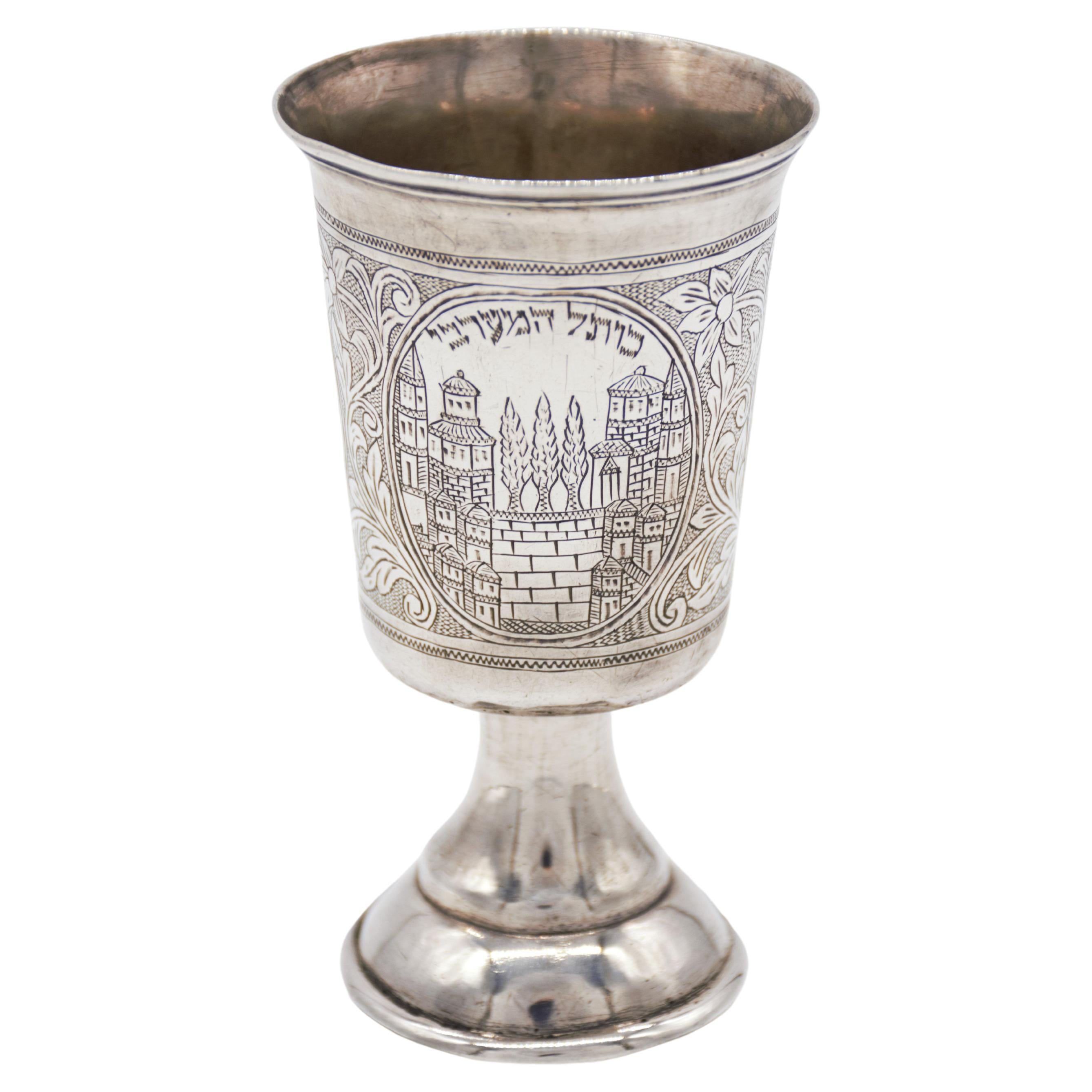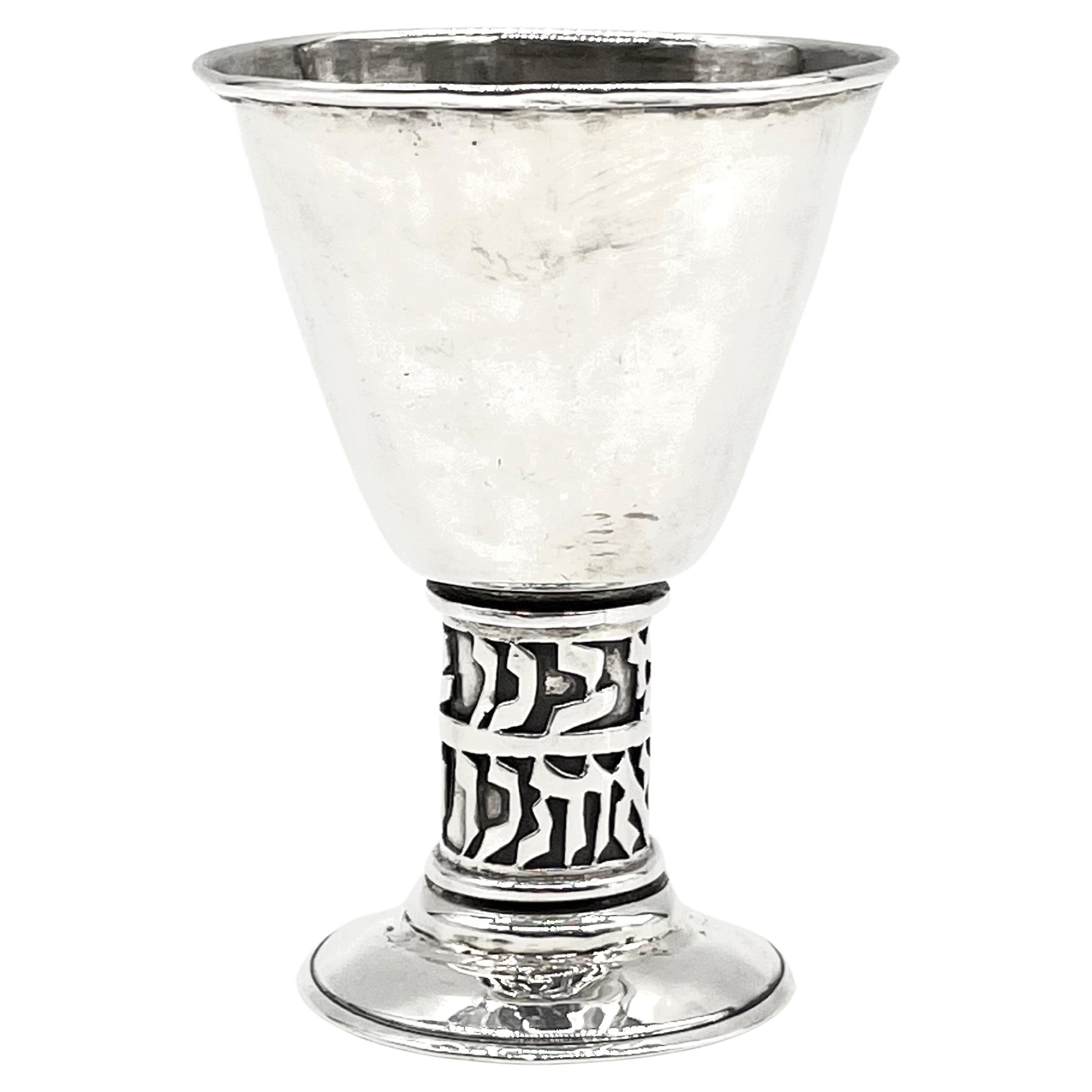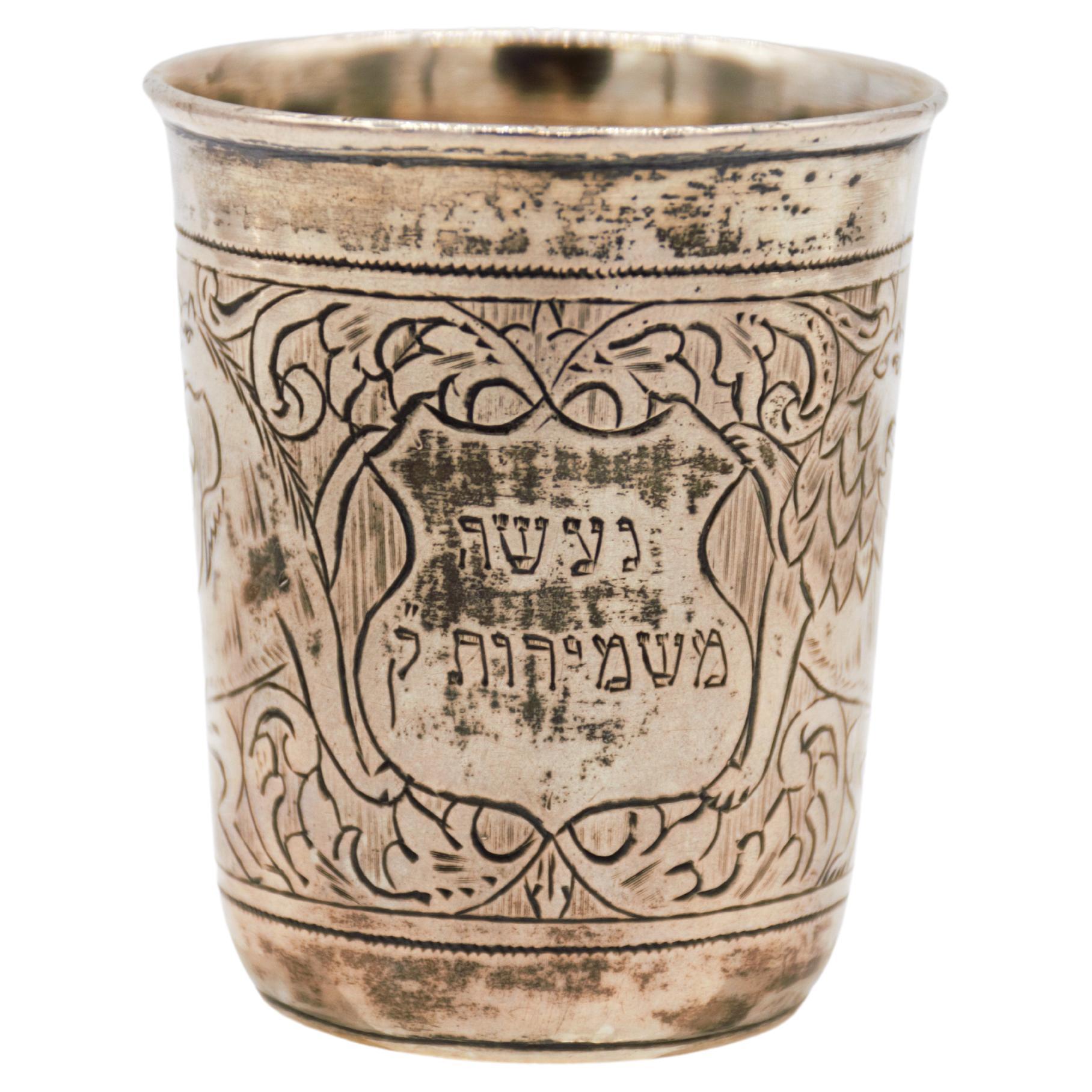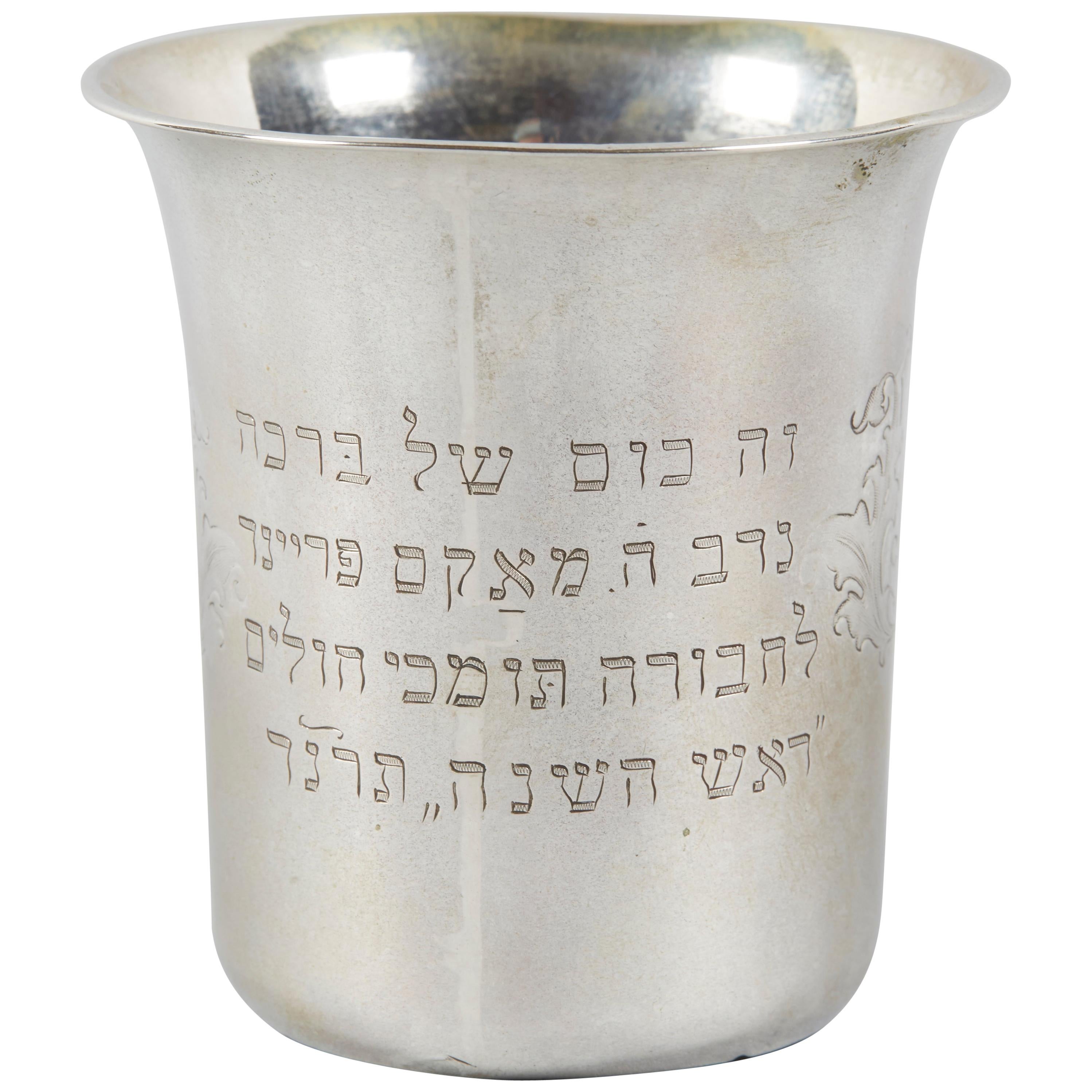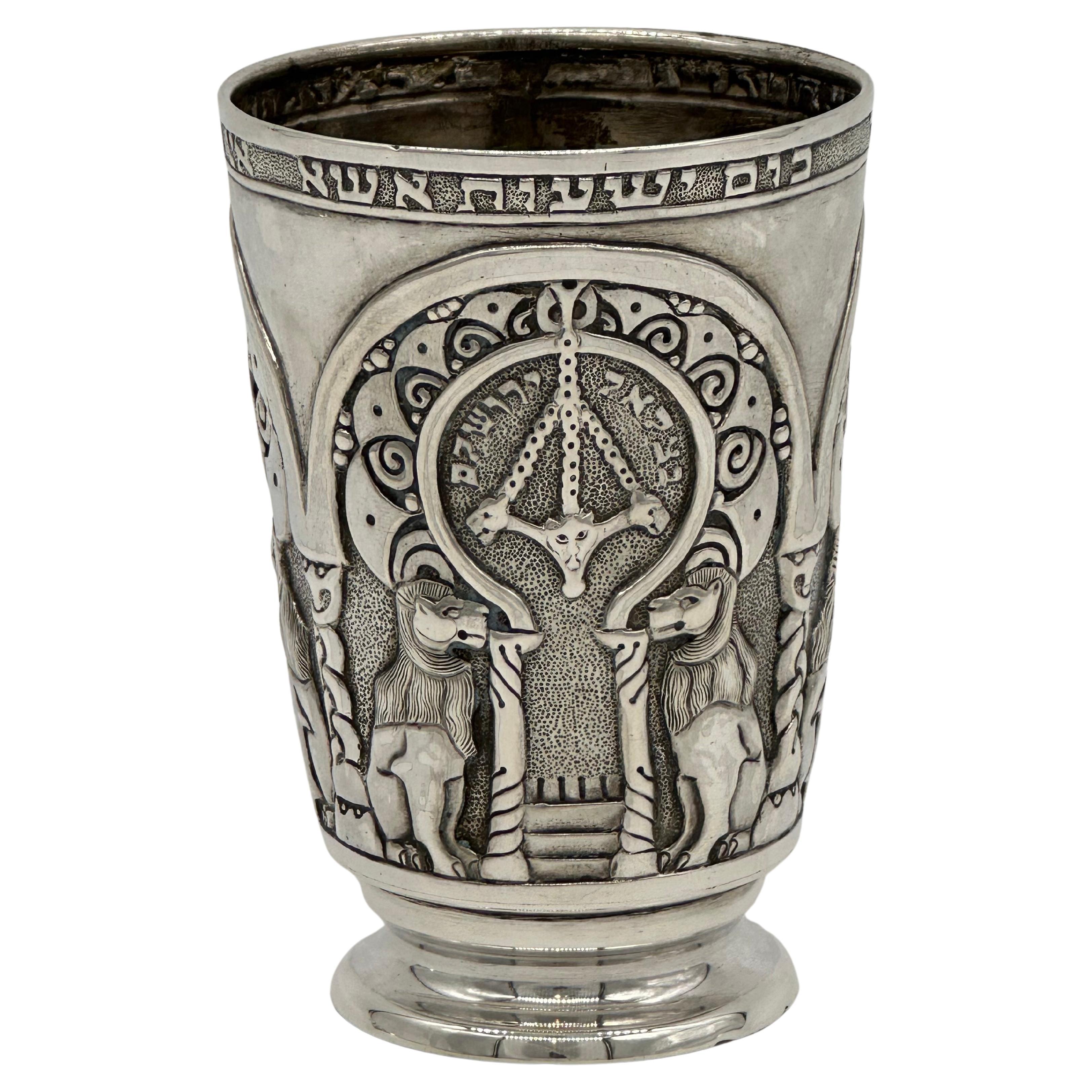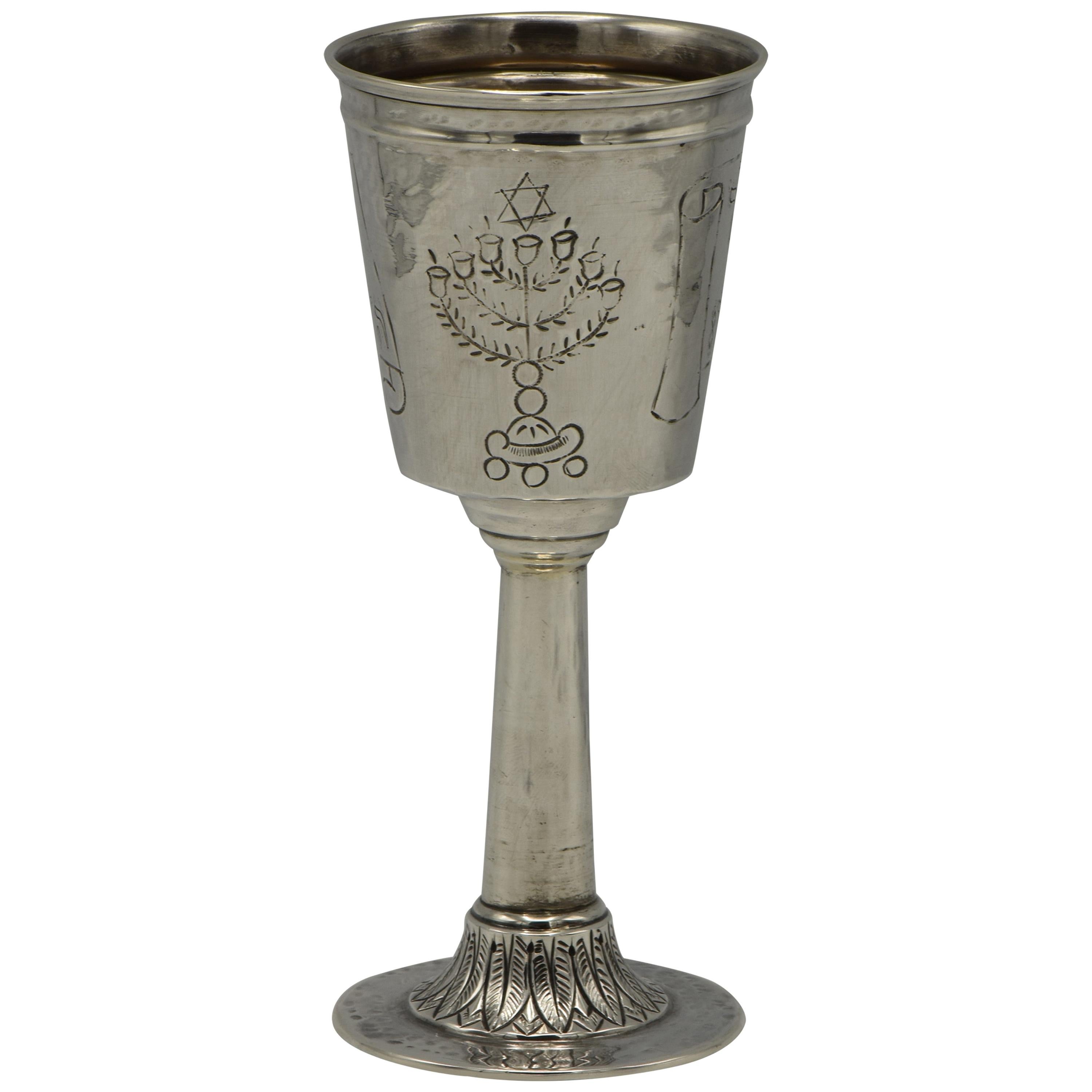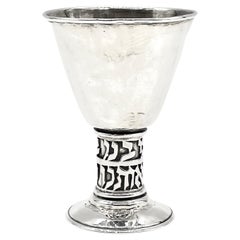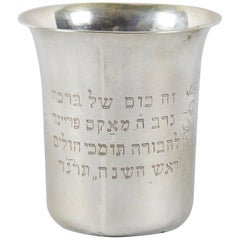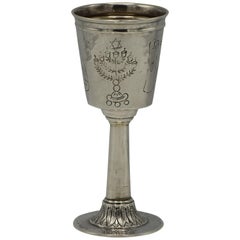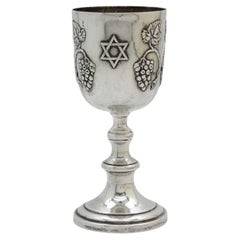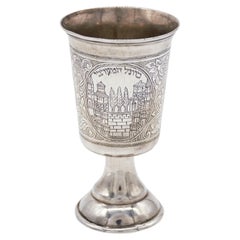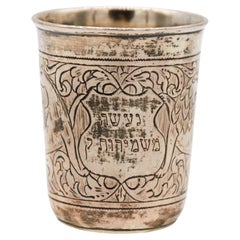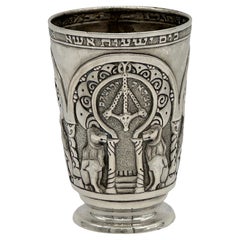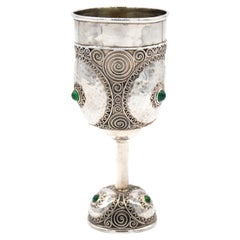Items Similar to Mid-20th Century Israeli Kiddush Cup by David Heinz Gumbel
Want more images or videos?
Request additional images or videos from the seller
1 of 6
Mid-20th Century Israeli Kiddush Cup by David Heinz Gumbel
$4,000
$5,00020% Off
£3,020.43
£3,775.5420% Off
€3,480.72
€4,350.9020% Off
CA$5,645.70
CA$7,057.1320% Off
A$6,224.26
A$7,780.3220% Off
CHF 3,256.33
CHF 4,070.4120% Off
MX$76,360.06
MX$95,450.0720% Off
NOK 40,990.74
NOK 51,238.4320% Off
SEK 38,332.82
SEK 47,916.0320% Off
DKK 25,994.09
DKK 32,492.6120% Off
About the Item
Hand hammered silver plate Kiddush cup with applied Hebrew text: "Peace be within your walls".
Signed on the bottom.
Kiddush cup is a ceremonial vessel to hold wine for the blessing said at Shabbat and Jewish holidays meals.
David Heinz Gumbel (given name was Detlev Heinz. He was born in Sinsheim, Germany to a secular family among the pioneers of the local silversmith industry. In 1918, the Gumbels relocated to Heilbronn where David worked as an apprentice in the "Bruckmann & Sons" factory, becoming a certified steel engraver.
In the late 1920s, Gumbel studied to be a silversmith at the school of applied arts in Berlin at the Kunstgewerbeschule. Following his studies, Gumbel was employed at workshops in Düsseldorf and Stockholm, as well as in the family factory in Heilbronn. It was there that Gumbel began to design hand-made silver pieces in the modern style. Simultaneously, he produced Jewish ritual objects like a Chanukah menorah or candlesticks. Gumbel utilized polished silver and other materials, such as ivory, in his works.
In 1936, Gumbel left Germany for Land of Israel, joining the Bezalel Academy of Arts and Design as a teacher and the administrator of the metal department, alongside Ludwig Yehuda Wolpert. Once in the Land of Israel, Gumbel began to work with typography, ostensibly as a result of Wolpert's influence.
Despite Gumbel's modern approach to design, he continued to work with and teach the traditional methods of manual manufacturing, such as repoussé. In the early 1940s, he opened an independent workshop where he produced metal works and Judaica pieces in said silversmith techniques.
Gumbel retired from his work at Bezalel in 1955. In his will Gumbel left the continuation of his creation to the artist Malka Cohavi, his assistant and teacher at Bezalel Academy of Art and Design.
Some of his most notable works: Candlestick of three arms (1930), Silver pouch for Declaration of Independence scroll (1949), Mezuzah case (1960), Etrog box (1975), Mezuza for the Supreme Court (1992), Early Modern Era silver Hanukkah Lamp (1950) and more.
- Dimensions:Height: 3.55 in (9 cm)Diameter: 2.76 in (7 cm)
- Materials and Techniques:
- Place of Origin:
- Period:
- Date of Manufacture:circa 1950
- Condition:
- Seller Location:New York, NY
- Reference Number:1stDibs: LU5281219359802
About the Seller
5.0
Recognized Seller
These prestigious sellers are industry leaders and represent the highest echelon for item quality and design.
Established in 2006
1stDibs seller since 2020
137 sales on 1stDibs
Typical response time: 8 hours
- ShippingRetrieving quote...Shipping from: New York, NY
- Return Policy
Authenticity Guarantee
In the unlikely event there’s an issue with an item’s authenticity, contact us within 1 year for a full refund. DetailsMoney-Back Guarantee
If your item is not as described, is damaged in transit, or does not arrive, contact us within 7 days for a full refund. Details24-Hour Cancellation
You have a 24-hour grace period in which to reconsider your purchase, with no questions asked.Vetted Professional Sellers
Our world-class sellers must adhere to strict standards for service and quality, maintaining the integrity of our listings.Price-Match Guarantee
If you find that a seller listed the same item for a lower price elsewhere, we’ll match it.Trusted Global Delivery
Our best-in-class carrier network provides specialized shipping options worldwide, including custom delivery.More From This Seller
View AllMid-20th Century Israeli Silver Kiddush Goblet by Hans Ettlinger
Located in New York, NY
Modern sterling silver Kiddush goblet designed by Hans Ettlinger.
Hand hammered in Jerusalem, Israel, circa 1950.
Stem embossed with...
Category
Mid-20th Century Religious Items
Materials
Silver
$3,100 Sale Price
20% Off
Late 19th Century Continental Silver Kiddush Cup
Located in New York, NY
Hand engraved silver Kiddush cup, 1894.
Engraved with Hebrew text: "This cup of Blessing donated by Max Freined for "Aid for sick" society,
Rosh Ha'Shana, ...
Category
Antique 1890s European Religious Items
Materials
Silver
$1,248 Sale Price
26% Off
Mid-20th Century Israeli Silver Kiddush Goblet by Moshe Smilovici
Located in New York, NY
Hand-hammered silver Kiddush goblet, Moshe Smilovici, Tel Aviv, Israel, circa 1950.
On round base engraved with leaves and tall stem. Upper wine section is engraved with the temple ...
Category
Mid-20th Century Israeli Religious Items
Materials
Silver
$980 Sale Price
20% Off
A 20th Century American Silver Kiddush Goblet
Located in New York, NY
This elegant 20th-century American silver Kiddush goblet is a striking example of refined Judaica design, blending traditional Jewish symbolism with classic American silversmithing o...
Category
20th Century American Sterling Silver
Materials
Sterling Silver
A Silver and Enamel Passover Kiddush Cup by Henryk Winograd, New York, 1995
Located in New York, NY
A Silver and Enamel Passover Kiddush Cup by Henryk Winograd, New York, 1995
Spectacular Kiddush cup for the Passover holiday beautifully embellished with floral and enamel motifs e...
Category
1990s Sterling Silver
Materials
Sterling Silver, Enamel
$6,960 Sale Price
20% Off
Free Shipping
A Silver Kiddush Goblet, Hungary Circa 1930
Located in New York, NY
A Dedicated Silver Kiddush Goblet, made in Hungary Circa 1930.
Seemingly this Kiddush Goblet was donated pre-WWll by a youth group in Galanta which at that time was part
of Hungary...
Category
Early 20th Century Hungarian Sterling Silver
Materials
Silver
$2,800 Sale Price
20% Off
You May Also Like
Rare "Safed" kiddush cup, late 19th century Poland/ Eretz ISRAEL
Located in Tel Aviv - Jaffa, IL
This 84 silver cup was made in Europe, in Poland or parts of Poland that are in modern Russia in the 19th century, the interesting and important in this cup types is that they were s...
Category
Antique 1890s Israeli Sterling Silver
Materials
Silver
A RARE SILVER SHMIROT KIDDUSH CUP. Galician, c. 1850.
Located in Tel Aviv - Jaffa, IL
A RARE SILVER SHMIROT KIDDUSH CUP. Galician, c. 1850.
Among some Hassidic courts, it was a practice for the Rabbi to give a blessed silver coin to his Hassidim as an amulet. Such protection might be given for all manner of life events, from healing from an illness to success in travel and the amulet was carried on the body of the recipient. This custom was particularly popular among the Ryzhiner Hassidim and these coins were called "Shmirot". To such coins were attributed extraordinary power and value and they were treasured with great care and love.
this cup is marked with polish loth 12 mark which indicate silver content of 75%.
Size :
Height 2.3 inch / 6 cm
Width : 2 inch / 5 cm
After the specific event for which they had originally be given, such a coin or coins were used in the making of other objects, which maintained the special aura of the Rabbi. Such a coin would be melted in other silver with the amuletic valued being spread evenly to all the silver. Then a ritual object would be fashioned by a silversmith and the special nature of the item would be inscribed on it, indicating in one of several ways that this object had been made from "Shmirot". this objects include Kiddish cups, a Havdalah tray, a Shabbat salt holder, a Chanukkah Menorah, a Torah crown etc.
This object is a Kiddish cup fashioned from such silver. On this cup, the inscription indicating Shmirot is found in the abbreviation of the words "made from shmirot k (kodesh)' " (This is the cup of Shmirot). Such cups were used for blessing the wine so that each use renewed the power of protection granted by the Rabbi. This cup was used for the blessing over wine on Shabbat and holidays. Inscription:
the other iconography on the cup is of a lion that represent Through the tribe of Judah, the lion symbol came to represent the blessing, majesty, and even divine protection of the Jews. The lion symbol continued to be used even after the destruction of Jerusalem, the capital of Judah's nation,
and a unicorn or a re'em, also reëm (Hebrew: רְאֵם), is an animal mentioned nine times in the Hebrew Bible It has been translated as "unicorn" in the Latin Vulgate, King James Version, and in some Christian Bible translations as "oryx" (which was accepted as the referent in Modern Hebrew),[citation needed] "wild ox", "wild bull", "buffalo" or "rhinoceros". Rabbi Natan Slifkin has argued that the re'em was an aurochs, as has Isaac Asimov...
Category
Antique 1850s Sterling Silver
Materials
Silver
Important Early 20th Century Silver Kiddush cup by Bezalel School Jerusalem
Located in Tel Aviv - Jaffa, IL
Important Handmade sterling silver Kiddush goblet by Bezalel School, Jerusalem, Circa 1910-1913.
On the cup there are 3 identical scenes of flanked lions and on the middle of them There are two columns with a staircase, this design is probably taken from Eastern European torah ark, on the middle part there is a chandelier with 3 tiger/lioness Heads, the top of the cup has 3 inscription on top of each flanking lions scene, first One says : ״כוס ישועות אשא״ (Psalms 116:13) which means " I will take the cup of Salvation", this is a rather common blessing on kiddush cups.
Next inscription says : ״אין שמחה אלא ביין״ in English " there is no joy except in wine" This says that after the temple was destroyed we have our joy only in the wine of Kiddish.
The last inscription says ״ושמחת בחגך״ (Deuteronomy 16:14 ) in English : "And you shall rejoice in your festival".
So this cup is a kiddish cup...
Category
Vintage 1910s Israeli Art Nouveau Sterling Silver
Materials
Silver
Important Early 20th Century Silver Kiddush Goblet by Bezalel School Jerusalem
Located in Tel Aviv - Jaffa, IL
Important Handmade sterling silver Kiddush goblet by Bezalel School, Jerusalem, circa 1910-1913.
On round base decorated with silver filigree and Cabouchon shaped green agate applications.
The base fitted with Bezalel mark. The upper portion is all adorned with amazing filigree work, the base and the actual cup adorned with swirling filigree designs, in the middle there are 3 roundels, made in another technique of hammered silver, similar to the works that were produced in this time all over Europe, in the middle of each roundel there is a perfectly centered Cabouchon green agate.
This work is attributed to Yehia Yemini.
The goblet is marked on the base, with the earliest silver mark of the school that just say "Bezalel" in Hebrew.
Yehia Yemini :
Was one of the biggest and must famous Bezalel silver...
Category
Early 20th Century Israeli Jugendstil Sterling Silver
Materials
Silver
Sterling Silver Kiddush Cup W/Hand Chased Linear Detailing & Star of David Motif
Located in New York, NY
This elegant sterling silver Kiddush cup, crafted in America circa 1960, features refined hand-chased linear detailing and a subtle Star of David motif. Thoughtfully integrated, the ...
Category
Vintage 1960s American Mid-Century Modern Sterling Silver
Materials
Sterling Silver
Russian 0.84 Silver 19th Century Kiddush Cup
Located in New York, NY
Russian 0.84 silver Kiddush cup from the mid- to late 19th century (possibly 1869?) showcasing stylized natural and architectural motifs. It measures 2 1/3'' in height by 2 1/8'' in...
Category
Antique 19th Century Russian Barware
Materials
Silver
More Ways To Browse
Israel Mid Century Modern Furniture
Israel Lamp
Jewish Religious Items
Menorah Mid Century
Judaica Menorah
Ivory Cup
Scroll Case
Kiddush Cup
Silver Plate Items Silver
Silver Hanukkah
Modern Kiddush Cups
Silver Hanukkah Lamp
Ceremonial Cup
Ludwig Yehuda Wolpert
Etrog Box
David Heinz Gumbel
Jewish Religious Items
Large Wooden Cross
